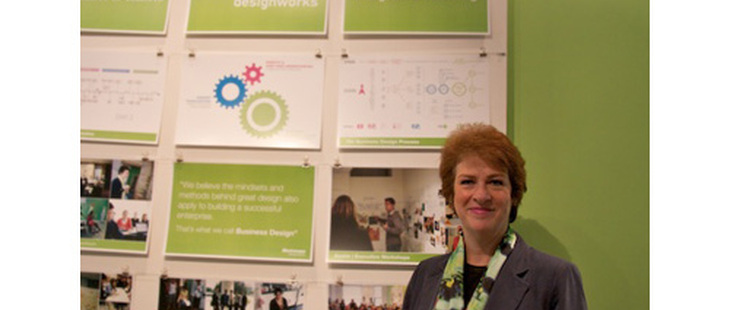
Are you a business that wants to innovate? Think like a designer. That’s the message from a growing number of consultants, business leaders, policy makers and educators who think companies need to swap obsessive analytics for more right-brain experimentation. While there’s a history of businesses turning to designers to help understand and enhance the whole user experience of their products (think Braniff Airline’s “End of the Plain Plane” gambit in the 1960s that, for a moment there, redesigned air travel), today what’s often called ‘Design Thinking’ is even finding its way into academia.
Toronto’s Rotman School of Management is a forerunner in teaching design methods to students and executives, providing them with new tools to solve today’s complex business challenges. Toronto Standard sat down with Heather Fraser, co-founder and director of DesignWorks, Rotman’s strategy innovation lab, to discuss how enterprises can foster revolutionary thinking from within.
+
Broadly speaking, just what is ‘design thinking’ and how are businesses using it?
‘Design thinking’ is a term used to represent the unique ways in which designers view the world and get the job done. I don’t like the term because everyone feels like they are being hijacked, but ‘business design’ puts the notion in the proper perspective. It’s about seeing a business as something that should be deliberately designed to be new, unique, and competitive using design-inspired methods and mindsets. It is about empathy, curiosity, creativity, and prototyping.
My whole life has been about making businesses more creative and how to make creatives more business-like. Business design is really about the integration of those two—how you take the best business practices and integrate them with design methods.
As I understand it, design thinking focuses on exploring future possibilities rather than making decisions exclusively on past market analysis. How does risk-taking figure in the process?
Really great business people are often willing to take a calculated risk. It not as much about proof, because you can never really prove anything, [but having] a reason to believe is probably the most important decision-making tool going forward.
Business design is about a series of quick wins and experiments. You might see where you want to go, have a big vision and strategy, but you don’t then execute the whole thing at once, it could cost you a fortune, disrupt your enterprise, and you could be out of business in a week. Instead you start with experiments—it doesn’t cost much, there is no risk to your business and there is good learning. When you look at big companies that have huge success long term, they experiment in rapid succession. Quick wins and experiments is an important part to mitigate the risk and move that forward.
Could you give us examples of companies that are leading the way with business design?
There are companies that do it intuitively, including Apple, Four Seasons (Izzy Sharp is an incredible design thinker and always has been), Virgin and Nespresso. They’ve got insight into their customer, they’re passionate about delivering a better experience at all times, and they’ve got really clear and distinct strategies.
Nespresso is an incredible example. First of all they are over-the-top passionate about coffee. They have people that are trained as baristas and coffee ambassadors all over the world, hundreds of them, and they have people that scout out the best beans, and they have this proprietary capsule. I don’t know if you’ve ever had a cup of their coffee but it’s a great cup of coffee. They are obsessed about the quality of the coffee and the quality of the experience, and they spend time perfecting the system.
They also decided, unlike the bigger Nestle, that they were going to focus on having a one-to-one personal relationship with customers. When you run out of capsules you call them up and a woman says “Bonjour,” and she sends you replenishments. If it is a day late she sends you a little thing of chocolates. So it is very personalized and exclusive. Another choice they made is to be socially and environmentally responsible. They had to ask, “What happens with these little capsules? We need a recycling program. We not only need a recycling program, but we have to think about the sustainability of the farming methods and the whole operation.”
Integration of this sort often results in designers and business people stepping on each others’ toes. How does business design foster collaboration without the hostility?
It’s important for businesses to come together to solve problems through multi-disciplinary collaboration. It is not about stepping on toes. Someone recently raised their hand at a talk (in an audience of designers) and said, “There was a guy here who said [that] all these business people think they are going to become designers and think they are doing your job…” I said, “Oh my gosh, no.” Business people who come to embrace this way of doing things want more designers to the table, not less. They are not trying to do their job, they are actually now appreciating it. That is an important distinction.
Are business leaders skeptical of design thinking as an idea?
I don’t think that they are skeptical, I just think they wonder “what is it?” and “how do you do it?” There’s always an image in the design world that it can be a little whimsical and not too deep or rigorous. But when I take them through it, they get it, and wonder why they weren’t doing it a long time ago. There is a lot of depth and analysis in business design. There are numbers, but it is about strategy before spreadsheets, it is about insight before metrics.
You can’t go into a marketplace and say, “Wow, there is a big opportunity because I talked to two people who have this eminent need.” You have to ask, “How can I substantiate that to get an idea as to how big that opportunity really is?” Same thing on the back-end—strategy is hard work, you have to synthesize, make hard choices and think about how your entire organization is going to be aligned with your strategy in order to deliver these ideas.
Who should lead business design initiatives?
It is usually at a senior level. If you are going to go down this path, and you really want to take this seriously as a cultural trigger, you need to think it through. You say, let’s start with a pilot [project], let’s figure how we can roll this out. Sometimes doing a one-off, a sort of hit-and-run, is not the answer.
Next week you have the Business Design Executive conference at the Rotman School of Management. How are you going to help participants kickstart the process of using design thinking to enhance their enterprises?
We will give them the opportunity to rediscover how insightful, creative and smart they are and help them shift their perspectives. We don’t do anything, they do all the work—we just give them some tools and methods and the license to think. The outcome: they discover a different way of doing things that is much smarter, more intuitive, and doesn’t compromise their business skills.
You were recently teaching business design in Singapore. How does the government want to implement this in the country’s thinking and policy making?
Singapore is one of the most advanced countries in the world when it comes to design. Honestly, I think you could add everyone in the world up and they wouldn’t be as ambitious as Singapore. They are investing in industries, education and design. They are a company, no a country—I keep calling them a company, but they are kind of like a company if you know how they operate—that continues to reinvent and innovate all the time.
Singapore decided that business design is something they want to teach to all of their up-and-coming entrepreneurs and various-sized companies. They also want to embed this in the school system. We are teaching 24 faculty at Singapore Polytechnic, [and they] are teaching it to 1,500 other faculty to teach to 15,000 students. We have a DesignWorks Singapore centre over there, and I think that is just a clue to how ambitious they are about being creative and innovative in the future.
The inaugural offering of the Business Design program will be held from September 26-28, 2011 at the Rotman School of Management. The program is “a three-day, intensive business design program is aimed at senior leaders who are responsible for driving innovation to create new customer value for their organization.” For more information see Rotman’s DesignWorks and Executive Program websites.
__
Raylene Knutson is an Assistant Editor at Toronto Standard.














